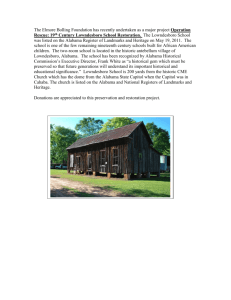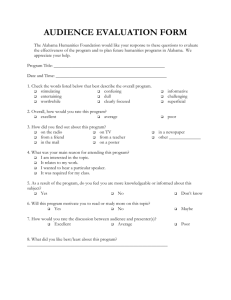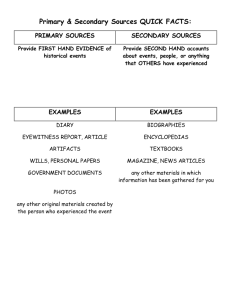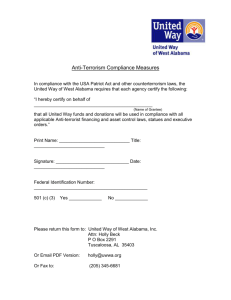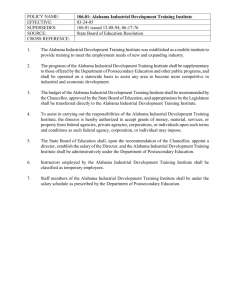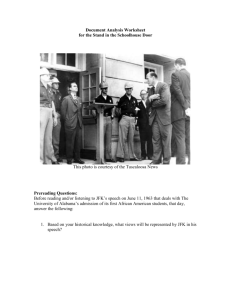APUSH 2014 versus ALABAMA COURSE OF STUDY
advertisement
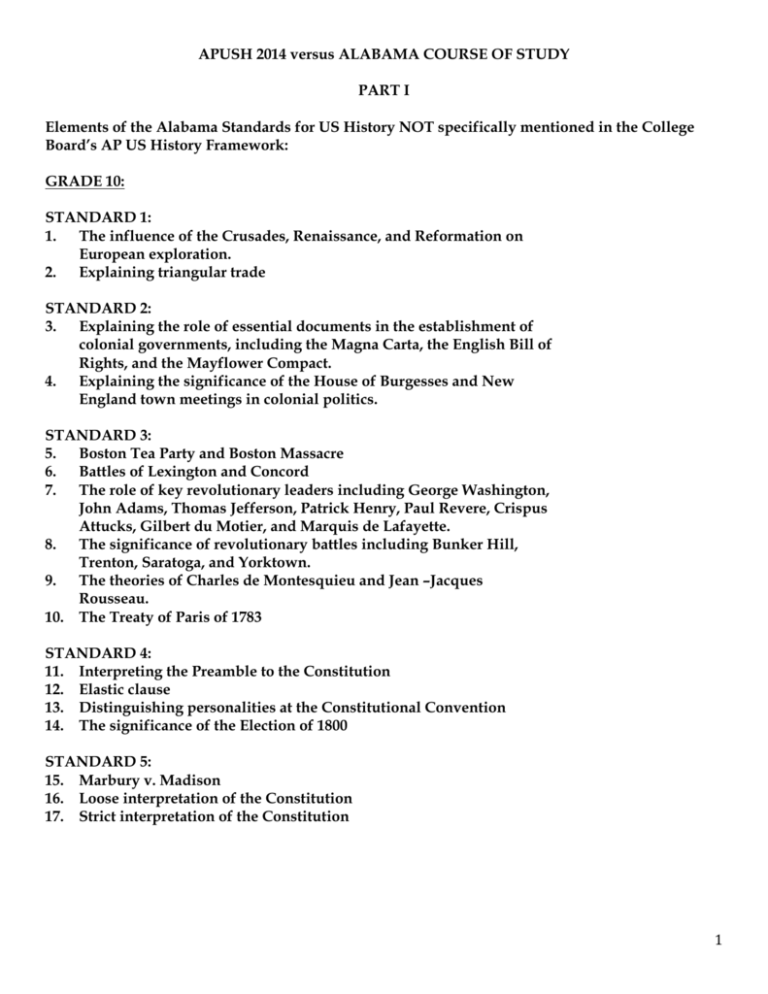
APUSH 2014 versus ALABAMA COURSE OF STUDY PART I Elements of the Alabama Standards for US History NOT specifically mentioned in the College Board’s AP US History Framework: GRADE 10: STANDARD 1: 1. The influence of the Crusades, Renaissance, and Reformation on European exploration. 2. Explaining triangular trade STANDARD 2: 3. Explaining the role of essential documents in the establishment of colonial governments, including the Magna Carta, the English Bill of Rights, and the Mayflower Compact. 4. Explaining the significance of the House of Burgesses and New England town meetings in colonial politics. STANDARD 3: 5. Boston Tea Party and Boston Massacre 6. Battles of Lexington and Concord 7. The role of key revolutionary leaders including George Washington, John Adams, Thomas Jefferson, Patrick Henry, Paul Revere, Crispus Attucks, Gilbert du Motier, and Marquis de Lafayette. 8. The significance of revolutionary battles including Bunker Hill, Trenton, Saratoga, and Yorktown. 9. The theories of Charles de Montesquieu and Jean –Jacques Rousseau. 10. The Treaty of Paris of 1783 STANDARD 4: 11. Interpreting the Preamble to the Constitution 12. Elastic clause 13. Distinguishing personalities at the Constitutional Convention 14. The significance of the Election of 1800 STANDARD 5: 15. Marbury v. Madison 16. Loose interpretation of the Constitution 17. Strict interpretation of the Constitution 1 STANDARD 6: 18. The XYZ Affair 19. Impressment STANDARD 7: 20. Treaty of Paris of 1783 21. Trail of Tears 22. Western Trails STANDARD 8: 24. Compare major events in Alabama from 1781 to 1823, including statehood as part of the expanding nation, acquisition of land, settlement, and the Creek War, to those of the developing nation. STANDARD 9: 25. Henry Clay 26. American System STANDARD 10: 25. Jacksonian Democracy 26. Common man ideal 27. Spoils system STANDARD 11: 28. Uniquely American writers including James Fenimore Cooper, Henry David Thoreau, and Edgar Allen Poe 29. Dorothea Dix STANDARD 12: 30. Describe the founding of the first abolitionist societies by Benjamin Rush and Benjamin Franklin. 31. Describe the role played by later critics of slavery, including William Lloyd Garrison, Sojourner Truth, Anglelina and Sarah Grime, Henry David Thoreau, and Charles Sumner. 32. Describe the rise of religious movements in opposition to slavery, including objections of the Quakers. 33. Describe the rise of the Underground Railroad. 34. Describe the impact of Harriet Beecher Stowe’s Uncle Tom’s Cabin on the abolitionist movement. STANDARD 13: 35. Fugitive Slave Acts 36. Describe Alabama’s role in the developing sectionalism of the United States from 1819 to 1861, including participation in slavery, secession, the Indian War, and reliance on cotton. 2 STANDARD 14: 37. The Anaconda Plan 38. Bull Run 39. Antietam 40. Vicksburg 41. Identify key Northern and Southern Civil War personalities including Jefferson Davis, Ulysses S. Grant, Robert E. Lee, Thomas “Stonewall” Jackson, and William Tecumseh Sherman. 42. Explain the reasons border states remained in the Union during the Civil War. 43. Morrill Act 44. Northern draft riots 45. Gettysburg Address 46. Role of women in American society during the Civil War, including efforts made by Elizabeth Blackwell and Clara Barton. 47. Tracing Alabama’s involvement in the Civil War. STANDARD 15: 48. The effectiveness of the Freedman’s Bureau 49. The role of carpetbaggers and scalawags 50. Black Codes 51. Rise of the Ku Klux Klan 52. Compromise of 1877 53. Explain the causes for the impeachment of President Andrew Johnson 54. Analyze the political and social motives that shaped the Constitution of Alabama of 1901 to determine their long-term effect on politics and economics in Alabama. STANDARD 16: 55. Agrarian rebellion over currency GRADE 11 STANDARD 1: 56. Congress of Industrial Organizations 57. Industrial Workers of the World 58. Pullman Strike 59. Haymarket Square Riot 60. Impact of Andrew Carnegie, Samuel Gompers, A. Philip Randolph, and Thomas Alva Edison STANDARD 2: 61. Assess the impact of the muckrakers on public opinion during the Progressive movement. 62. Impact of Upton Sinclair, Jacob A. Riis, and Ida M. Tarbell 63. Sherman Antitrust Act 64. Niagara Movement 65. W.E.B. DuBois 66. Marcus Garvey 3 67. 68. 69. Carter G. Woodson Assess the significance of the public education movement initiated by Horace Mann. Compare the presidential leadership of Theodore Roosevelt, William Howard Taft, and Woodrow Wilson in obtaining passage of measures regarding trust-busting, the Hepburn Act and the Pure Food and Drug Act. STANDARD 3: 70. Yellow journalism 71. Sinking of the Battleship U.S.S. Maine 72. The Rough Riders 73. The iconic status of Theodore Roosevelt 74. Appraise Alabama’s contributions to the United States between Reconstruction and World War I, including those of William Crawford Gorgas, Joseph Wheeler, and John Tyler Morgan. 75. Evaluate the role of the Open Door policy 76. Evaluate the role of the Roosevelt Corollary 77. Big Stick Diplomacy STANDARD 4: 78. Identify the role of militarism, alliances, imperialism, and nationalism in causing World War I. 79. Explain how the Treaty of Versailles led to worsening economic and political conditions in Europe, including greater opportunities for the rise of fascist states in Germany, Italy, and Spain. 80. Comparing short-and-long term effects of changing boundaries in pre-and post-World War I in Europe and the Middle East, leading to the creation of new countries. STANDARD 5: 81. Scopes Trial 82. Ku Klux Klan activities 83. W.C. Handy 84. Zelda Fitzgerald 85. Analyze the words of major American artists and writers, including F. Scott Fitzgerald, Ernest Hemingway, and H. L. Mencken to characterize the era of the 1920s. STANDARD 6: 86. Assess the impact of overproduction, stock market speculation, and restrictive monetary policies on the pending economic crisis. 87. Describe the impact of the Smoot-Hawley Tariff Act on the global economy and the resulting worldwide depression. 88. Identify notable authors of the 1930s including John Steinbeck, William Faulkner, and Zora Neale Hurston. 89. Dorothea Lange 4 STANDARD 7: 90. Works Progress Administration 91. Civilian Conservation Corps 92. Dust Bowl STANDARD 8: 93. Summarize events leading to World War II including the militarization of the Rhineland, Germany’s seizure of Austria and Czechoslovakia, Japan’s invasion of China, and the Rape of Nanjing. 94. Analyze the impact of fascism, Nazism, and communism on growing conflicts in Europe. 95. Identify the roles of significant World War II leaders including Dwight Eisenhower, George S. Pattton, Sir Winston Churchill, Bernard Montgomery, Joseph Stalin, Benito Mussolini, Emperor Hirohito, Erwin Rommel, and Adolf Hitler. 96. Evaluate the impact of the Munich Pact and the failed British policy of appeasement. STANDARD 9: 97. Describe the significance of major battles, events, and consequences of World War II campaigns, including North Africa, Midway, Normandy, Okinawa, the Battle of the Bulge, Iwo Jima, and the Yalta and Potsdam Conferences. 98. Locate on a map the major battles of World War II 99. Explain the reasons for and results of dropping atomic bombs on Japan. 100. Explain the events and consequences of war crimes committed during World War II including the Holocaust, the Bataan Death March, the Nuremberg Trials, the post-war Universal Declaration of Human Rights, and the Genocide Convention. STANDARD 10: 101. G.I. Bill of Rights 102. Describe Alabama’s participation in World War II 103. Tuskegee Airmen STANDARD 11: 104. Truman Doctrine 105. Marshall Plan 106. Berlin Blockade 107. Domino Theory 108. McCarthyism 109. Alger Hiss Case 110. Execution of Julius and Ethel Rosenburg STANDARD 12: 111. Major initiatives of the Kennedy administration 112. Space race 113. Alabama’s role in the space program 5 114. 115. 116. Construction of the Berlin Wall Bay of Pigs invasion Cuban Missile Crisis STANDARD 13: 117. Battle of Dien Bien Phu 118. Gulf of Tonkin Resolution 119. Tet Offensive 120. Destabilization of Laos 121. Secret bombing of Cambodia 122. Fall of Saigon 123. Locating on a map or globe the divisions of Vietnam, the Ho Chi Minh Trail, and major battle sites 124. Describe the creation of North and South Vietnam STANDARD 14: 125. Montgomery Bus Boycott 126. Desegregation of Little Rock Central High School 127. March on Washington 128. Freedom Rides 129. Sixteenth Street Baptist Church bombing 130. Selma-to-Montgomery March 131. Contributions of Dr. King, James Meredith, Medgar Evers, SCLC, SNCC, CORE, NAACP, and the civil rights foot soldiers. 132. Describe the development of the Black Power movement. 133. Appraise the contributions of persons and events in Alabama that influenced the modern Civil Rights Movement including Rosa Parks, Autherine Lucy, John Patterson, George C. Wallace, Vivian Malone Jones, Fred Shuttlesworth, the Children’s March, and key local persons and events. 134. Describe the economic impact of African-American entrepreneurs on the modern Civil Rights Movement, including S.B. Fuller and A.G. Gaston. PART II Elements of the College Board Framework that are NOT part of the Alabama Standards for U.S. History. It is important to remember that the Framework elements are not optional. According to the Framework, “every AP Exam question will be rooted in these specific learning objectives.” (page 1) PERIOD 1: 1491 - 1607 The College Board Framework calls for teachers to devote 5 percent of their classroom time or 9 lessons to the period from 1491 to 1607. Like most states, the Alabama Standards begin with the European settlements along the Atlantic coast during the 17th Century. The College Board’s decision to devote 5 percent of the course to the 6 period from 1491 to 1607 did not happen by accident. The unelected College Board curriculum writers use this time period to establish their theme that “Many Europeans developed a belief in white superiority to justify their subjugation of Africans and American Indians, using several different rationales.” The theme of “white superiority” and the “subjugation of Africans and American Indians” plays a key role in the College Board Framework. PERIOD 2: 1607 - 1754 1. The development of “a rigid racial hierarchy” in the English colonies. (page 27) 2. The “strong belief in British racial and cultural superiority” (page 28). 3. Spanish colonizing efforts in North America, particularly the Pueblo Revolt. (page 30) 4. “Atlantic World commercial, religious, philosophical, and political interactions among Europeans, Africans, and American native peoples.” (page 30) 5. The “emergence of a trans-Atlantic print culture” was one of several factors that promoted Anglicization in the British colonies. (page 30) PERIOD 3: 1754 - 1800 6. “Throughout the second half of the 18th Century, various American Indian groups repeatedly evaluated and adjusted their alliances with Europeans, other tribes, and the new United States government.” (page 32) 7. Chief Little Turtle and the Western Confederacy (page 32) 8. “The American Revolution and the ideals set forth in the Declaration of Independence had reverberations in France, Haiti, and Latin America, inspiring future rebellions.” (page 35) 9. March of the Paxton Boys (page 36) 10. Corridos (page 36) 11. Architecture of Spanish missions (page 36) 12. “The Constitution’s failure to precisely define the relationship between American Indian tribes and the national government…” (page 37) 13. Republican motherhood (page 37) PERIOD 4: 1800 - 1848 14. “Many white Americans in the South asserted their regional identity through pride in the institution of slavery…” (page 38) 15. Charles G. Finney (page 39) 16. Hudson River School (page 39) 17. John James Audubon (page 39) 18. Slave music (page 40) 19. “The market revolution helped to widen the gap between rich and poor, shaped emerging middle and working classes, and caused an increasing separation between home and workplace, which led to dramatic transformations in gender and in family roles and expectations.” (page 41) 20. Cult of domesticity (page 41) 7 PERIOD 5: 1844 – 1877 21. “The idea of Manifest Destiny, which asserted U.S. power in the Western Hemisphere and supported U.S. expansion westward, was built on a belief in white racial superiority and a sense of American cultural superiority, and helped to shape the era’s political debates.” (page 44) 22. Know-Nothings (page 46) 23. Mormons (page 46) 24. Sand Creek Massacre (page 46) 25. “States’ rights, nullification, and racist stereotyping provided the foundation for the Southern defense of slavery as a positive good.” (page 46) 26. Minstrel shows 27. Hiram Revels and Blanche K. Bruce (page 48) PERIOD 6: 1865 – 1898 28. Mother Jones (page 50) 29. “Business interests battled conservationists as the latter sought to protect sections of unspoiled wilderness through the establishment of national parks and other conservationist and preservationist measures.” (page 51) 30. “As transcontinental railroads were completed, bringing more settlers west, U.S. military actions, the destruction of the buffalo, the confinement of American Indians to reservations, and assimilationist policies reduced the number of American Indians and threatened native culture and identity.” (page 52) 31. Henry George (page 53) 32. Gospel of Wealth (page 53) PERIOD 7: 1890 – 1945 33. Clayton Antitrust Act (page 55) 34. “World War I created a repressive atmosphere for civil liberties, resulting in official restrictions on freedom of speech.” (page 56) 35. Yiddish theater (page 56)) 36. Edward Hopper (page 56) 37. Bracero program (page 57) 38. “Although the American Expeditionary Force played a relatively limited role in the war…” (page 58) 39. “Wartime experiences, such as the internment of Japanese Americans, challenges to civil liberties, debates over race and segregation, and the decision to drop the atomic bomb raised questions about American values.” (page 59) PERIOD 8: 1945 – 1980 40. “Postwar decolonization and the emergence of powerful nationalist movements in Asia, Africa, and the Middle East led both sides in the Cold War to seek allies among new nations, many of which 8 remained nonaligned.” (page 60) 41. Military-industrial complex (page 61) 42. John Lewis (page 61) PERIOD 8: 1945-1980 CONT: 43. Fannie Lou Hammer (page 61) 44. “Activists began to question society’s assumptions about gender and to call for social and economic equality for women and for gays and lesbians.” (page 62) 45. “Liberalism reached its zenith with Lyndon Johnson’s Great Society…” (page 62) 46. Griswold v. Connecticut (page 63) 47. Students for a Democratic Society (page 63) 48. Phyllis Schlafly (page 64) PERIOD 9: 1980 – PRESENT 49. “President Ronald Reagan, who initially rejected détente with increased defense spending, military action and bellicose rhetoric, later developed a friendly relationship with Soviet leader Mikhail Gorbachev, leading to significant arms reductions by both countries.” (page 66) 50. “Don’t Ask, Don’t Tell debate” (page 68) 9

